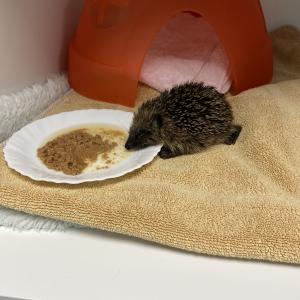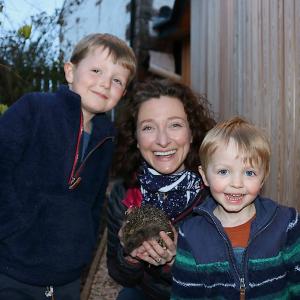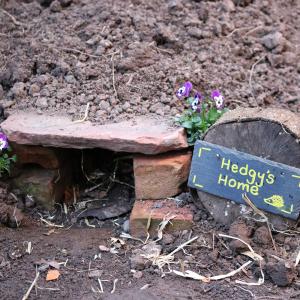
It was a particularly horrid and stormy evening one weekend in October last year and it was my turn to be on call. I received a call from a concerned member of the public who had found a very small and lifeless hedgehog on his way home from work. Admittedly, on my way to the practice, I thought to myself it would probably need to be euthanised, as all too often they are brought to us in such a poor state that we can’t do anything for them and it is kinder to put them to sleep.
But, happily when I opened the small shoe box what I saw gave me some hope. She lifted her head a little in response to the light, and although she was tiny and nearly comatose, her temperature was low and she was covered in fly eggs, she had a strong heartbeat and I couldn’t find any nasty wounds on her or broken bones.

In the veterinary profession, we have taken an oath that commits us to ‘the constant endeavour to ensuring the health and welfare of animals committed to my care’. And although euthanasia sometimes plays its part in the welfare of badly injured animals and those that are suffering, I didn’t feel this was appropriate for this little hedgehog, not until I had done what I could to give her supportive treatment and time to assess how she was going to fare.
I gave her warmed supportive fluid therapy, she was conscious enough to swallow so I syringe fed her recovery cat food, I gave her a warm bath I removed as many fly eggs as I could manually and used an insecticide spray for those that I couldn’t get to. On further examination, she did have a couple of wounds that needed some attention so I cleaned these up and applied Manuka honey (it’s great in encouraging healing in wounds). One wound was a little infected so I started her on a course of antibiotics. And to keep her comfortable and from suffering I gave her some pain relief.
Fed, bathed, warmed, treated and settled into a cosy bed with food and water on hand, I left her until the morning. I was a little anxious that it was going to be too much for her and I would find her passed away in the kennel in the morning but happily this was not the case. Our early nurse came into the prep room to meet me with a big smile on her face saying the hedgehog is up and about and is scoffing her way through her second breakfast!

Once her wounds were healing nicely and she was starting to gain a little weight we had to decide what we were going to do with her through the winter, she was too small and underweight to survive hibernation outdoors so I volunteered our spare room at home for her to spend the winter, put on some weight and gain her strength. Since then she has snuffled and rustled around in her makeshift pen, my children have helped me clean her out every 3-4 days, providing her with fresh bedding and plenty of hedgehog food and fresh water.
As Spring approaches and wild hedgehogs are starting to emerge sleepily from their hibernation, I have done as much research I can regarding her release and have been liaising with the British Hedgehog Preservation Society and they have kindly provided me with the information I needed. Ideally she would go back to where she came from, as even youngsters develop a mind map of the area they were born into, this however is not possible for this little hedgehog, for a few reasons, so the next best thing is to release her somewhere that is safe and where other hedgehogs reside. So, it looks as though little Hedgy (as she has so imaginatively been named by my children) will be sticking around in our garden, hopefully. We have spent some time making a corner of our garden a little bit wilder, where we will let the grass grow long, we’ve built a nice hide and provided bedding for her where we will be able to give her fresh water and supplement her feeding while she settles in. We are prepared for her not choosing to live with us and we may never see her again. But at least I will know we have done everything we have for her and given her the second best start in life. That is enough for me. And the icing on the cake would be to see her and two little hoglets in tow tottering around the garden at dusk one night.

Sadly, hedgehog numbers in the UK are declining, mainly due to habitat loss and safe routes for them to roam their territories, they are often seen squashed on roads or badly injured by cars by the roadside. Even our own gardens can be dangerous places for hedgehogs, strimmers and lawn mowers can badly damage them or kill them. Slug bait used to control garden pests is highly toxic and they will die if they eat it or eat a poisoned slug or snail. Bonfires piles are very tempting for them to nestle down in in the autumn to hibernate in, but are fatal if they become asphyxiated or burnt in them.
I am so keen to encourage everyone but in particular youngsters to be aware of the natural wildlife around them and to develop an interest in them, to care about them and to do what we can to help protect them, for their future survival. But also to benefit ourselves as it has been shown that engaging with nature has positive effects on our wellbeing.
I am aware that my children have been so lucky to be able to have one over wintering in their home, and sadly there are lots of youngsters that haven’t even seen a live hedgehog. I feel education is key, but also working with societies such as the British Hedgehog Preservation Society and Knoxwood and getting the message out there that we need to do more to look after these little guys and other wildlife to ensure their survival and biodiversity.
I am so grateful to the member of the public who brought her to me that horrid stormy night in October, for if they hadn’t, she would not have survived. And I would not have been able to tell you her story. And it is thanks to little Hedgy that I have started on this journey to do what we can to protect them and raise awareness of their plight.